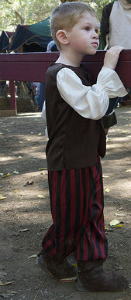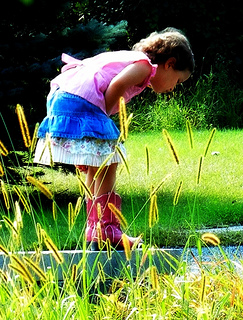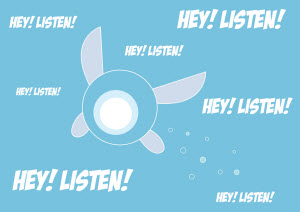Kids, man. They change everything. They’re loud and adorable and messy and sweet and foolish and curious. They make you do things you would never otherwise do, like sing in public or wake up at dawn. For their parents, they’re as close as anyone can come to immortality.
For a good GM, though, they’re a possible plot hook.
You probably don’t often encounter child characters in your tabletop game. After all, what kind of kid spends his time wandering through dungeons and hanging out with wargs? (Answer: an awesome one.) What kind of parent lets their child approach a group of bloody, bedraggled strangers that just stumbled into town?
Kids aren’t always appropriate to include as NPCs, but when they work within your setting, they can be powerful characters.
Better Than An Escort Mission
Children aren’t generally helpless, at least once they get past the toddler stage, but they’re also far from independent. That’s sort of the whole reason why they need to live with their parents for eighteen plus years. They need the help, guidance, strength, and wisdom of adults. They need to be nurtured and protected, not only from the world, but also from themselves.
In an RPG setting, this dependence can set up evocative storylines and draw PCs further into the game world. Depending on the party’s relationship to the child, the GM can provoke responses and emotions that would be difficult with any other character.
Take, for instance, the case of the ward. A PC who cares for a child is forced to come to terms with the fact that there is something other than the preservation of his or her own skin vying for importance. That PC might realize that he has to sacrifice himself in order to save his younger sister, or that he has to be more cautious in battle for fear of not being able to fulfill his role as caretaker. On the other hand, the PC might realize that he doesn’t want to bother with his ward. He wants to go adventuring, and he doesn’t want some whiny little girl tagging along. Well, that’s fine, too, as long as he realizes that there are consequences for ignoring his duties. Perhaps his ward falls ill, and there’s no one to care for her but the mysterious stranger from down the street. Or she goes missing and is halfway across the kingdom before the PC notices.
 PCs may consider doing things that they otherwise wouldn’t when children are involved. Some characters (and players) are prone to the noble sacrifice. I’ll throw myself before the demon in order to buy my party some extra time. Having a child NPC can play with this trope. On the one hand, characters may be more likely to martyr themselves to save an innocent kid. If the party or PC is responsible for caring for a child, though, the noble sacrifice may not be so appealing. Without the PC, who will be there to protect the child? Who will care for it? Suddenly, the party has to find a new way to solve this problem – one that doesn’t involve their sure death.
PCs may consider doing things that they otherwise wouldn’t when children are involved. Some characters (and players) are prone to the noble sacrifice. I’ll throw myself before the demon in order to buy my party some extra time. Having a child NPC can play with this trope. On the one hand, characters may be more likely to martyr themselves to save an innocent kid. If the party or PC is responsible for caring for a child, though, the noble sacrifice may not be so appealing. Without the PC, who will be there to protect the child? Who will care for it? Suddenly, the party has to find a new way to solve this problem – one that doesn’t involve their sure death.
We’re primed to feel an emotional connection to children. It’s pretty important in terms of the survival of our species. Of course, this is not to imply that every individual loves kids – I think we all know how false that is. But, overall, we find developing ties with kids to be emotionally rewarding.
A good GM will use this to their advantage. We feel for kids, with all their innocence and vulnerabilities, and a GM can use this to draw PCs into their storyline and evoke strong emotional responses. This is particularly fun in a horror game, where the PCs must work together to save the child/children from the Big Bad.
Of course, along with the strong emotions comes the potential for those emotions to bleed out of the magic circle created by the game. People have issues around kids, and endangering children in game – even though those children aren’t real – can be triggering (or simply not fun) for some players. Make sure you check in ahead of time, because it’s one thing to push boundaries during gaming, but it’s another thing to break them completely.
A Whole New POV
Spend about five minutes in the company of someone under the age of seven and you’ll realize that children are definitely not just mini adults. Their brains are works-in-progress – they have different neural pathways and they’re capable of much greater flexibility. Until about seven, they aren’t capable of fully rational thought – and even then our brains continue to develop until we’re in our late-twenties. This is one of the reasons for the magical thinking inherent in children, for the blend of fantasy and reality that marks a young child’s play.
All of this means that kids see the world differently. Where an adult sees danger, a kid sees adventure (and a GM sees a story). For us, the rules of the universe are strict and inflexible, but for a child, there is no real impossible.
This often comes up in the trope of the child that can commune with things his or her parents don’t even know is there – ghosts, fairies, imaginary friends. Winnie the Pooh, Coraline, and Peter Pan are all variations on this tale of the child who goes someplace that only children can know of.
This can be somewhere innocent and fun, like the Hundred Acre Wood, or someplace more sinister, like the island of the lost boys. The movie The Others also has an interesting twist on this, where the children are the only ones who can see the real world, while the world of their mother is one of half-truths and assumptions.
Tropes aside, the use of children can be used to introduce your setting – particularly the more fantastic elements. They have a knack for pointing out parts of the world that adults gloss over, and they can get away with saying and doing things that would get an adult PC thrown in the dungeon.
Why? Why? Why? Why? Why?
Why are you an adventurer? What’s that rope for? Have you seen any monsters? What kind? Did you kill them? Was there blood? Was it fun? Have you ever been to a tavern?
And so on.
There’s little mystery around why kids relate so well to Curious George. They’re little question machines, and it’s basically their job to figure out how the world works. Curiosity gets them into all kinds of trouble, and this is an important aspect to touch on when developing a child NPC. It can lead to some wonderful plot devices, as well as to PC growth and depth. How the PC reacts to a child asking it a million and one questions can tell a lot about that PC’s personality and value system – way more than a two-word descriptor, at least. My cleric might be lawful good, but she’s impatient and doesn’t want to waste time with kids. She’s a very different character, then, than the lawful good paladin who spends an evening regaling the village children with tales of adventure and piety.
It’s important not to go overboard here, though. No one wants to be followed around by Navi, after all. Make your child NPCs adorable or flawed or creepy or grating, but try not to make them downright annoying. Players often already have ways of annoying each other – it doesn’t need to come from the NPCs as well.
Child NPCs can be a weakness or a strength in your game. Their success will depend on how they’re used by the GM and how they’re tied to the party. Either way, though, they’re an often-overlooked storytelling tool, and they’re powerful for the automatic reactions they involve in many people (and players). If you’re looking to change things up or add depth to your campaign, try introducing a child NPC.
![]()
Erin Ryan is a regular contributor to the site, and is a fan of trying out different storytelling devices. Except those involving Navi. Because seriously. Feel free to share your thoughts with us over on our social media pages!
Photo Credits: Boy Waif by davitydave; Girl at Pond by Diane Cordell; Navi by Chris Mendoza.


